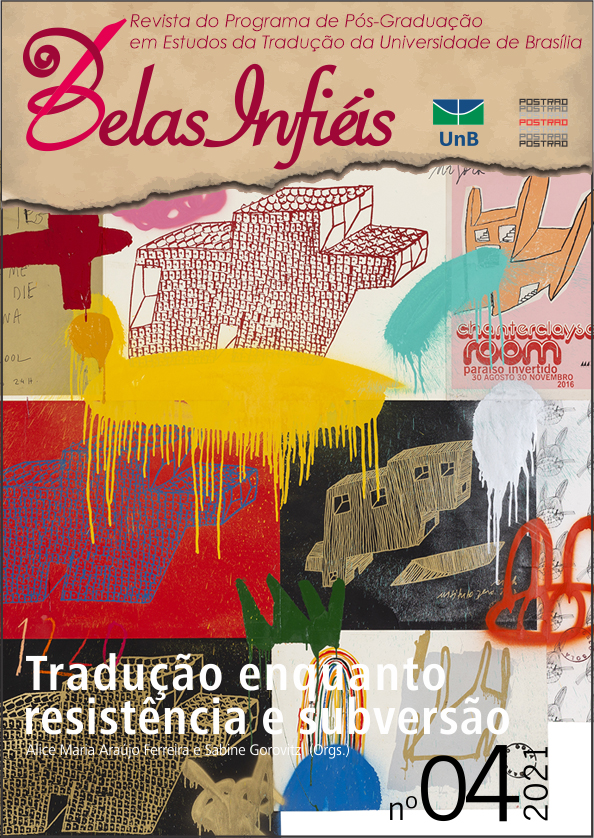The Construction of the Other in Translation, Photography and Comics
DOI:
https://doi.org/10.26512/belasinfieis.v10.n4.2021.36209Keywords:
Cultural Representation. Comics Translation. Photography. Comics Journalism.Abstract
This article reflects on the construction of cultural representations based on the French graphic novel Le protographe (O fotógrafo, in Brazil). This work of comics journalism reports on the Soviet occupation of Afghanistan in the 1980s and uses photography as a narrative resource alongside drawings. Based on this, we reflect on the construction of the reality of the other, that is, from abroad, through the translation process, based on the analysis of excerpts from the work in which alterity is configured. Due to its formal nature, Le photographe allows one to think about the construction of the other from the perspective of translation, photography, and the narrative structure of comics. In this sense, it appears that the cultural perspective of Translation Studies can be extended to multimodal languages, that is, that are configured from the conjunction of different sign systems, which can contribute to new debates and reflections on the translation of widely translated forms of media, such as comics.
Downloads
References
Aragão, S. M. (2020). Scanlation: de fã a tradutor. In K. Hanna & D. Silva-Reis (Orgs.), A tradução de quadrinhos no Brasil: princípios, práticas e perspectivas (pp. 183–203). Lexikos.
Arístegui, G. de. (2004). El islamismo contra el islam: las claves para entender el terrorismo yihadista. Ediciones B.
Barbosa, A., & Cunha, E. T. (2006). Antropologia e imagem. Jorge Zahar.
Berman, A. (1984). L’épreuve de l’étranger: culture et traduction dans l’Allemagne romantique. Gallimard.
Bhabha, H. K. (2013). O local da cultura (M. Ávila, E. L. de L. Reis, & G. R. Gonçalves, Trads.). Editora UFMG.
Boria, M., Carreres, Á., Noriega-Sánchez, M., & Tomalin, M. (Eds.). (2020). Translation and multimodality: beyond words. Routledge.
Chartier, R. (1991). O mundo como representação (A. Daher & Z. C. Reis, Trads.). Estudos avançados, 5(11), 173–191. https://doi.org/10.1590/S0103-40141991000100010
Delesse, C., & Richet, B. (2009). Le coq gaulois à l’heure anglaise: analyse de la traduction anglaise d’Astérix. Artois Presses Université.
Eisner, W. (1999). Quadrinhos e arte sequencial (L. C. Borges, Trad.). Martins Fontes.
Foucault, M. (1969). L’archéologie du savoir. Gallimard.
Guibert, E., Lefèvre, D., & Lemercier, F. (2004). Le Photographe, 2. Dupuis.
Guibert, E., Lefèvre, D., & Lemercier, F. (2006). Le Photographe, 3. Dupuis.
Guibert, E., Lefèvre, D., & Lemercier, F. (2008). O fotógrafo, 2 (D. de Bruchard, Trad.). Conrad Editora do Brasil.
Hall, S. (2000). Quem precisa da identidade? (T. T. da Silva, Trad.). In T. T. da Silva (Org.), Identidade e diferença: a perspectiva dos estudos culturais (pp. 103–133). Vozes.
Hanna, K., & Silva-Reis, D. (2020). A tradução de quadrinhos no Brasil: princípios, práticas e perspectivas. Lexicos.
Keesing, R. (1974). Theories of culture. Annual review of anthropology, (3), 73–97.
Koch, I. G. V. (2004). Introdução à linguística textual: trajetória e grandes temas. Martins Fontes.
Kossoy, B. (2009). Realidades e ficções na trama fotográfica. Ateliê Editorial.
Laraia, R. de B. (1986). Cultura: um conceito antropológico. Zahar.
Makhmalbaf, M. (2001). O Afeganistão (C. E. Charity, Trad.). Publifolha.
Metcalf, B. D. (1982). Islamic revival in British India, 1860-1900. Royal Book Company.
Oittinen, R., Ketola, A., & Garavini, M. (2018). Translating Picturebooks: revoicing the verbal, the visual and the aural for a child audience. Routledge.
Pimentel, C. (2018). Tradução de histórias em quadrinhos: teoria e prática. Transitiva.
Pym, A. (2010). Exploring translation theories. Routledge.
Rashid, A. (2003). Jihad: a ascensão do islamismo militante na Ásia Central (A. Candelária, Trad.). Cosac & Naify.
Sabbagh, A. N. (1988). Dicionário árabe – português – árabe. Ed. UFRJ.
Schleiermacher, F. D. E. (2010). Sobre os diferentes métodos de tradução (C. R. Braida, Trad.). In W. Heiderman (Org.), Clássicos da teoria da tradução (pp. 39–99). UFSC, Núcleo de Tradução. (Über die verschiedenen Methoden des Übersetzens. Obra original publicada em 1838)
Snell-Hornby, M. (1988). Translation studies: an integrated approach. John Benjamins.
Sontag, S. (2003). Diante da dor dos outros (R. Figueiredo, Trad.). Companhia das Letras.
Venuti, L. (1998). The scandals of translation: towards an ethics of difference. Routledge.
Wolf, M. (1997). Translation as a process of power: aspects of cultural anthropology in translation. In M. Snell-Hornby, Z. Jettmarová, & K. Kaindl (Eds.), Translation as intercultural communication (pp. 123–133). John Benjamins.
Zavaglia, A., Xatara, C., & Silva, M. C. P. da. (2010). Xeretando a linguagem em francês. Disal.
Downloads
Published
How to Cite
Issue
Section
License
Copyright (c) 2021 CC BY

This work is licensed under a Creative Commons Attribution 4.0 International License.
Given the public access to this journal, the texts are free to use but requires the recognition of the original authorship and initial publication in this journal to be properly stated.
 The journal allows the use of works published for non-commercial purposes, including the right to submit the work to publicly accessible databases. Published contributions are the sole and exclusive responsibility of the author(s).Â



















